Chicago and North Western Transportation Company
The Chicago and North Western Transportation Company (reporting mark CNW) was a Class I railroad in the Midwestern United States. It was also known as the "North Western". The railroad operated more than 5,000 miles (8,000 km) of track as of the turn of the 20th century, and over 12,000 miles (19,000 km) of track in seven states before retrenchment in the late 1970s. Until 1972, when the employees purchased the company, it was named the Chicago and North Western Railway (or Chicago and North Western Railway Company).
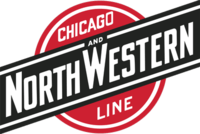 | |
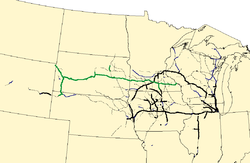 Map of the Chicago and North Western Railway. Black lines are trackage now owned by the Union Pacific Railroad, green lines are owned by the Dakota, Minnesota and Eastern Railroad, blue lines are owned by other railroads, and dotted lines are abandoned. | |
| Overview | |
|---|---|
| Headquarters | Chicago, Illinois |
| Reporting mark | CNW |
| Locale | Illinois, Iowa, Kansas, Michigan, Minnesota, Missouri, Nebraska, North Dakota, South Dakota, Wisconsin, and Wyoming |
| Dates of operation | 1865–1995 |
| Successor | Union Pacific Railroad Some trackage in Wisconsin is now operated by the Wisconsin and Southern Railroad |
| Technical | |
| Track gauge | 4 ft 8 1⁄2 in (1,435 mm) standard gauge |
The C&NW became one of the longest railroads in the United States as a result of mergers with other railroads, such as the Chicago Great Western Railway, Minneapolis and St. Louis Railway and others. By 1995, track sales and abandonment had reduced the total mileage to about 5,000. The majority of the abandoned and sold lines were lightly trafficked branches in Iowa, Illinois, Minnesota, South Dakota and Wisconsin. Large line sales, such as those that resulted in the Dakota, Minnesota and Eastern Railroad, further helped reduce the railroad to a mainline core with several regional feeders and branches.[1] Union Pacific (UP) purchased the company in April 1995 and integrated it with its own operation.
History
1859 to 1968
.jpg)
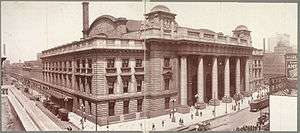
.png)
The Chicago and North Western Railway was chartered on June 7, 1859, five days after it purchased the assets of the bankrupt Chicago, St. Paul and Fond du Lac Railroad. On February 15, 1865, it merged with the Galena and Chicago Union Railroad, which had been chartered on January 16, 1836. Since the Galena & Chicago Union started operating in December 1848, and the Fond du Lac railroad started in March 1855, the Galena and Chicago Union Railroad is considered to be the origin of the North Western railroad system. The Winona and St. Peter Railroad was added to the network in 1867. Other lines acquired included Sioux City and Pacific Railroad and Fremont, Elkhorn and Missouri Valley Railroad in 1884, and the Milwaukee, Lake Shore and Western Railway in 1893.
Changing traffic patterns and competition with automobiles and trucking disrupted the railroad's profitability by mid-20th century. After nine years in bankruptcy, the C. & N. W. was reorganized in 1944. It had turned rapidly to diesel power, and established a huge diesel shop in Chicago. Its Proviso Freight Yard, located 12 miles (19 km) west of the city center in suburban Cook County, was constructed between 1926 and 1929 and remained the largest such in the world, with 224 miles of trackage and a capacity of more than 20,000 cars.
Potatoes from the west were a main crop loading of the C. & N. W., and its potato sheds in Chicago were the nation's largest. It also carried western sugar beets and huge amounts of corn and wheat. This road, like other lines depending strongly on transportation of crops, was adversely affected by government agricultural credit policies which sealed a lot of products on the farms where they were produced. Although it stood sixteenth in operating revenue in 1938, it was eighth in passenger revenue among American railroads. It served Chicago commuters; its 400 streamliners provided intercity transportation, and it provided an eastern link to bring the Union Pacific's passengers from Omaha, Nebraska and points west to Chicago.[2]
The North Western had owned a majority of the stock of the Chicago, St. Paul, Minneapolis and Omaha Railway (Omaha Road) since 1882. On January 1, 1957, it leased the company, and merged it into the North Western in 1972. The Omaha Road's main line extended from an interchange with the North Western at Elroy, Wisconsin, to the Twin Cities, south to Sioux City, Iowa, and then finally to Omaha, Nebraska.
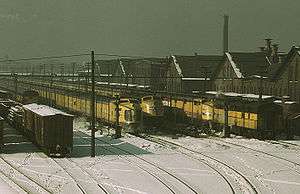
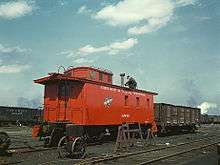
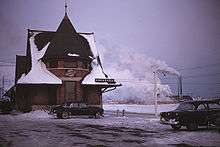
The North Western acquired several important short railroads during its later years. It completed acquisition of the Litchfield and Madison Railway on January 1, 1958. The Litchfield and Madison railroad was a 44-mile (71 km) bridge road from East St. Louis to Litchfield, Illinois. On July 30, 1968, the North Western acquired two former interurbans — the 36-mile (58 km) Des Moines and Central Iowa Railway (DM&CI), and the 110-mile (180 km) Fort Dodge, Des Moines and Southern Railway (FDDM&S). The DM&CI gave access to the Firestone plant in Des Moines, Iowa, and the FDDM&S provided access to gypsum mills in Fort Dodge, Iowa.
On November 1, 1960, the North Western acquired the rail properties of the 1,500-mile (2,400 km) Minneapolis and St. Louis Railway. In spite of its name, it ran only from Minneapolis, Minnesota, to Peoria, Illinois. This acquisition provided traffic and modern rolling stock, and eliminated competition.
1968 to 1984
On July 1, 1968, the 1,500 mi (2,400 km) Chicago Great Western Railway merged with the North Western. This railroad extended between Chicago and Oelwein, Iowa. From there lines went to the Twin Cities, Omaha, Nebraska, and Kansas City, Missouri. A connection from Hayfield, Minnesota, to Clarion, Iowa, provided a Twin Cities to Omaha main line. The Chicago Great Western duplicated the North Western's routes from Chicago to the Twin Cities and Omaha, but went the long way. This merger provided access to Kansas City and further eliminated competition. After abandoning a plan to merge with the Milwaukee Road in 1970, Benjamin W. Heineman, who headed the CNW and parent Northwest Industries since 1956, arranged the sale of the railroad to its employees in 1972; they formed Northwest Industries to take over the CNW in 1968.[3] The words "Employee Owned" were part of the company logo in the ensuing period. The railroad was renamed from Chicago and North Western Railway to Chicago and North Western Transportation Company. The railroad's reporting marks (CNW) remained the same.
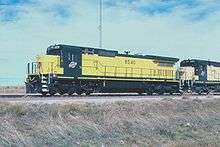
After the Chicago, Rock Island and Pacific Railroad (Rock Island) ceased operating on March 31, 1980, the North Western won a bidding war with the Soo Line Railroad to purchase the roughly 600-mile (970 km) "Spine Line" between the Twin Cities and Kansas City, Missouri, via Des Moines, Iowa. The Interstate Commerce Commission (ICC) approved North Western's bid of $93 million on June 20, 1983. The line was well-engineered, but because of deferred maintenance on the part of the bankrupt Rock Island, it required a major rehabilitation in 1984. The company then began to abandon the Oelwein to Kansas City section of its former Chicago Great Western trackage, which duplicated Spine Line service.
1985 to 1995
In 1985, the CNW Corporation was formed to take over the Chicago and North Western Transportation Company; the employee-owned stock of the Chicago and North Western Transportation Company was transferred to the new CNW Corporation.
In 1988, the Blackstone Capital Partners, L.P. formed the Chicago and North Western Acquisition Corporation to purchase the CNW Corporation; the CNW Corporation was acquired by Blackstone Capital Partners under the Chicago and North Western Acquisition Corporation subsidiary from the employee owned stock; Blackstone Capital Partners now controls the CNW Corporation and the Chicago and North Western Transportation Company under the Chicago and North Western Acquisition Corporation subsidiary. Chicago and North Western Holdings Corporation (or "CNW Holdings Corporation" and "Chicago and North Western Holdings Company") was formed and took control of the Chicago and North Western Acquisition Corporation which controlled the CNW Corporation and which the CNW Corporation controlled the Chicago and North Western Transportation Company.[3]
The Chicago and North Western corporate structure under the Blackstone ownership:[4]
- Chicago and North Western Holdings Corporation
- Chicago and North Western Acquisition Corporation
- CNW Corporation
- Chicago and North Western Transportation Company (formerly Chicago and North Western Railway)
- CNW Corporation
- Chicago and North Western Acquisition Corporation
In February 1994, the Chicago and North Western Acquisition Corporation and the CNW Corporation merged into the Chicago and North Western Holdings Corporation, leaving only the Chicago and North Western Holdings Corporation and the Chicago and North Western Transportation Company. In May 1994, the Chicago and North Western Transportation Company reverted to its original name, Chicago and North Western Railway and the Chicago and North Western Holdings Corporation was renamed to the second Chicago and North Western Transportation Company.[5]
The Chicago and North Western corporate structure now follows:
- Chicago and North Western Transportation Company (formerly Chicago and North Western Holdings Corporation)
- Chicago and North Western Railway (formerly Chicago and North Western Transportation Company)
In April 1995, the Union Pacific Corporation acquired the former Chicago and North Western Holdings Corporation (the second Chicago and North Western Transportation Company) under subsidiary UP Rail (or UP Rail, Inc.), Union Pacific now controls the former Chicago and North Western Holdings Corporation (now the second Chicago and North Western Transportation Company) and the Chicago and North Western Railway (formerly the first Chicago and North Western Transportation Company) under UP Rail subsidiary.[6][5]
The Chicago and North Western corporate structure under Union Pacific ownership:
- UP Rail (or UP Rail, Inc.)
- Chicago and North Western Transportation Company (formerly Chicago and North Western Holdings Corporation)
- Chicago and North Western Railway (formerly Chicago and North Western Transportation Company)
- Chicago and North Western Transportation Company (formerly Chicago and North Western Holdings Corporation)
The Union Pacific Corporation merged UP Rail into the Union Pacific Railroad and then merged the second Chicago and North Western Transportation Company and the Chicago and North Western Railway into the Union Pacific Railroad; the Chicago and North Western system is now part of the Union Pacific Railroad system.[7] A joint UP-CNW subsidiary, Western Railroad Properties, Inc., was also merged into the Union Pacific system in the acquisition.
Post C&NW
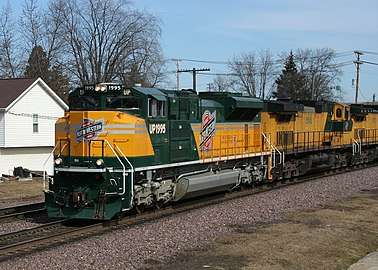
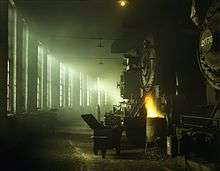
Chicago and North Western locomotives continued to operate in their own paint schemes for several years after the acquisition (although some of them were gradually repainted into UP colors.) Many former C&NW units have received "patches" with a new road number and reporting mark to match their new owner's roster. Only 2 "patched" units remain on the Union Pacific, UP 6706, and UP 9771. Several others work under different owners. However, it is still possible to find untouched C&NW units in service. For instance CNW 1518, CNW 411, CNW 414 (METX 308), and CNW 6847 are preserved at the Illinois Railway Museum, CNW 4153 now works at a grain elevator in Fremont, Nebraska, and several other GP7s, GP9s, and a few other C&NW locomotives are owned by various regional railroads, short lines, or industries.
Union Pacific continues to follow its new tradition of releasing "Heritage" EMD SD70ACe units to represent the paint schemes of companies absorbed by UP. After completion of painting at the Wisconsin and Southern Railroad's Horicon, Wisconsin shop, UP 1995, painted in a "Heritage" C&NW paint scheme, was unveiled on July 15, 2006, at North Western Station in Chicago, Illinois. The former North Western Station, now known as the Ogilvie Transportation Center, now serves as UP's Metra terminus for its three lines (Union Pacific/West Line, Union Pacific/Northwest Line, and Union Pacific/North Line). However, many longtime Chicago residents still refer to the station as "North Western Station," and many longtime employees still call it "CPT," for "Chicago Passenger Terminal."
C&NW Tables
| C&NW + CStPM&O | CGW | M&StL | L&M | |
|---|---|---|---|---|
| 1925 | 9866 | 1967 | 1217 | 28 |
| 1933 | 5641 | 1430 | 645 | 38 |
| 1944 | 13609 | 3104 | 1503 | 89 |
| 1960 | 12225 | 2474 | 1181 (merged C&NW 1960) | (merged C&NW) |
| 1970 | 19729 | (merged) |
| C&NW | CStPM&O | CGW | M&StL | L&M | |
|---|---|---|---|---|---|
| 1925 | 8469 | 1842 | 1496 | 1628 | 44 |
| 1956 | 7787 | 1616 | 1470 | 1397 | 44 |
| 1970 | 11046 | ||||
| 1981 | 8256 |
Passenger train service
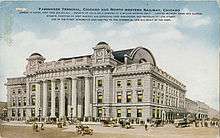
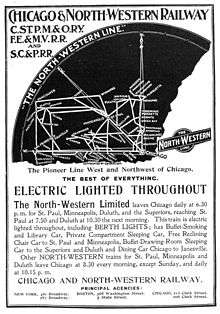
The CNW's most famous train, the Twin Cities 400 from Chicago to Minneapolis/St. Paul, was introduced in 1935 to compete with the Chicago, Burlington and Quincy's Zephyrs and the Milwaukee Road's Hiawathas. This train was named so, because it traveled the 400 mi (640 km) between the cities in 400 minutes. CNW was the first system to start a high-speed Chicago-Twin Cities schedule because it used refurbished instead of new equipment, but in 1939, modernized the 400 with new E3A diesel locomotive pairs and streamlined cars. Other named trains the CNW operated included the Ashland Limited, Duluth-Superior Limited, and the North Western Limited[8] CNW eventually renamed the first 400 to the Twin Cities 400 as the CNW labeled almost all of its passenger trains with variations of the 400 moniker, including the Flambeau 400, Minnesota 400, Valley "400", Shoreland "400", Dakota 400 and the Kate Shelley 400.[9] CNW ceased running the Twin Cities 400 in 1963, and all intercity passenger service on CNW ended with the formation of Amtrak in 1971.
Amtrak bought a dozen of C&NW's bilevel railcars and painted them into Phase III paint, they were used with Amtrak's EMD F40PH locomotives. They are not in use today.
In conjunction with Union Pacific and Southern Pacific, the North Western operated some long distance passenger trains, including the Overland Limited, City of Los Angeles, City of San Francisco, City of Denver, and the Challenger. These services lasted from 1889 to 1955, after which the CNW route to Chicago was changed to the Milwaukee Road's on account of poor track conditions.
.jpg)
.jpg)
Chicago and North Western also operated commuter train service in the Chicago area, where they developed what was perhaps the first control car. A modified gallery car was built in 1960 with locomotive controls to allow push-pull operation. Today, it is preserved at the Illinois Railway Museum.[10] The C&NW also pioneered the concept of Head End Power (HEP), generating 480 volt electricity from the locomotive to power the air conditioning, lighting, and heating on the new bi-level cars. This eventually became the standard for all railroads in the United States.
Three commuter lines radiated from North Western Station; the C&NW West Line to Geneva, Illinois; the C&NW Northwest Line to Harvard, Illinois; and the C&NW North Line to Kenosha, Wisconsin. All three are still operated by Metra. At Crystal Lake Junction, some trains branched off to Williams Bay and Lake Geneva, Wisconsin. The West Line also had branches to St. Charles, Aurora, Freeport, and Crystal Lake. A fourth commuter line operated on the KD Line between Kenosha and Harvard until 1939.
In 1974, responsibility for the commuter lines and equipment ownership transferred to the newly formed Regional Transportation Authority, later branded in 1983 as Metra. A "purchase of service" contract was signed with the C&NW, by which the railroad would be paid to maintain the line and operate trains on behalf of Metra. This arrangement continues with the Union Pacific today.
All three C&NW commuter lines live on in the Metra system, with the Geneva line having been extended west to Elburn; however, service on the branch to Williams Bay was gradually cut back over the years, also resulting in changes to the name of the branch. In 1965, service was abandoned between Williams Bay and Lake Geneva. In 1975, service ended between Lake Geneva and Richmond. In 1981, service between McHenry and Richmond ended. Rails and ties north of the Cargill plant in Ringwood were removed during the 1980s, and the right of way converted to a trail. Service was discontinued to St. Charles in 1951. Service between Geneva and Aurora and Elgin and Crystal Lake was discontinued in the early 1930s. Service to Freeport ceased in the late 1940s.
Additional notes
Operations

The CNW was known for running on the left-hand side when running on double track mainlines. In the United States, most railroads used the right-hand track along double-track mainlines, while left-hand running was more common in countries where British companies built the railroads. According to a display in the Lake Forest station, the reason for this was a combination of chance and inertia. When originally built as single-line trackage, the C&NW arbitrarily placed its stations on the left-hand side of the tracks (when headed inbound toward Chicago). Later, when a second track was added, it was placed on the side away from the stations so as not to force them to relocate. Since most passengers waiting at the stations were headed toward Chicago, the inbound track remained the one closest to the station platforms. The expense of reconfiguring signals and switches has prevented a conversion to right-hand operation ever since.
The Chicago and North Western was known for its installation of Western Railroad Supply Company wigwag signals at many of its crossing in the 1920–1940s. Almost every town on their route had at least the main crossing in town protected by them. The most common style were the Center Harp shorties. They were almost iconic to the CNW. Many of them, which were grandfathered in after the Federal Railroad Administration ruled them inadequate protection in 1949, survived until the 1970s and a few remain on lines in Wisconsin that have been sold off to other railroads. Lack of available parts and upgrades to roads have replaced all but a few of them.
The railroad operated what was once the largest "potato yard" or potato market, at its Chicago Wood Street yards. Potatoes came to the yard from every point in the United States to be bought or traded by produce dealers and brokers. While the facility came to be known as the "potato yard", it was also a site where other vegetables could be bought, sold or traded.[11][12]
Logo
In 1891, the CNW adopted the famous "ball and bar" logo, which survived a few modifications throughout its 104-year existence. This included the changing of text:
- The North Western Line (1891-1902)
- Chicago & North Western Line (1902-1944)
- Chicago & North Western System (1944-1957)
- Chicago & North Western Railway (1957-1971)
- North Western: Employee Owned (1971-1982)
- Chicago & North Western System (1982-1995)
Reused rolling stock
The railroad also purchased a great deal of its equipment second-hand. CNW shop forces economized wherever possible, earning the railroad the nickname "Cheap and Nothing Wasted." Sometimes employees referred to the condition of equipment as "Cardboard and No Wheels."
Rail trails
One of the first rail trails created in the United State was the 32.5-mile (52.3 km) Elroy-Sparta State Trail in Wisconsin, which used a segment abandoned in 1965.
The Cowboy Trail is a rail trail that follows the abandoned CNW line between Chadron, Nebraska and Norfolk, Nebraska. When completed, it will be 321 miles in length.
The Sangamon Valley Trail is another rail trail, currently 5.5-mile (8.9 km) in length, on the west side of Sangamon County in Illinois, which skirts Springfield, Illinois. It is a segment of a former St. Louis, Peoria and North Western Railway 38-mile (61.2 km) right-of-way (which was later folded into the CNW) that has been set aside for rail trail use. The entire right-of-way connects Girard, Illinois, on the south end, to Athens, Illinois, at the north end. The right-of-way spans the western half of Sangamon County in a north-south direction, and also traverses small sections of Macoupin County and Menard County.
The Wild Rivers Trail is a 104-mile-long rail trail that follows the abandoned CNW line between Rice Lake, Wisconsin and Superior, Wisconsin.
Notable employees
- Silas B. Cobb, Chicago industrialist and philanthropist, former member of C & NW board of directors.
- Clarence Darrow, noted attorney and a former Chief Counsel for the C & NW.
- Albert Hammond, Wisconsin State Assemblyman
- Fred H. Hildebrandt, U.S. Congressman from South Dakota
- Charles Ingalls, De Smet, South Dakota (1879–1880); father of Laura Ingalls Wilder
- Carl Ingold Jacobson, Los Angeles, California; City Council member, 1925–1933.
- William B. Ogden, the first mayor of Chicago and the first President of the C & NW.
- Merritt Clarke Ring, Neillsville, Wisconsin; lawyer and politician.
- Abe Saperstein, founder of the Harlem Globetrotters.
- Perry H. Smith, Chicago, Illinois, politician and businessman.
- George Gilbert Swain, Delton, Wisconsin, politician.
Chicago and North Western Historical Society
The Chicago and North Western Historical Society was organized by a number of railfans in 1973. The Society's purpose is to preserve the history and memory of the Chicago and North Western Railway through the publication of a quarterly magazine, the preservation of railroad paraphernalia, and an Annual Meet. The Society's journal, North Western Lines, is published four times a year.
See also
References
Citations
- "Chicago & North Western 1385". midcontinent.org. Archived from the original on May 11, 2008. Retrieved September 10, 2007.
- Watters, Mary; Illinois In The Second World War - Volume II: The Production Front (1952). Illinois State Historical Library, p. 154-156
- "Chicago and North Western Transportation Company (CNW) records". Northern Michigan University Archives Collections. February 10, 2015. Archived from the original on September 4, 2017. Retrieved September 3, 2017.
- Klein, Maury (June 15, 2011). Union Pacific: The Reconfiguration: America's Greatest Railroad from 1969 to the Present. Oxford University Press. ISBN 978-0199910410. Retrieved February 24, 2018.
- "Chicago & North Western Transportation Co/DE – '10-K'". U.S. Securities and Exchange Commission. December 31, 1994.
- Feder, Barnaby J. (March 11, 1995). "COMPANY NEWS; Union Pacific to Buy Chicago and North Western". The New York Times. ISSN 0362-4331. Retrieved April 5, 2015.
- "Chicago & North Western Transportation Co/DE – '10-K'". United States Securities and Exchange Commission. March 17, 1997.
- Chicago And North Western System [Time Table]. Rand McNally, March 14, 1948
- Scribbins, Jim (2008) [1982]. The 400 Story. Minneapolis, Minnesota: University of Minnesota Press. ISBN 978-0-8166-5449-9.
- Phillips, Dave (September 1999). "C&NW Gallery Cars". Rail & Wire. Illinois Railway Museum. Archived from the original on February 16, 2009. Retrieved January 6, 2010.
- "World's largest Potato Yard Found in Chicago". The Ellensburgh Capital. January 2, 1948. Retrieved March 1, 2012.
- Murray, Tom, ed. (2008). Chicago & North Western Railway. Voyageur Press. p. 63. ISBN 0-7603-2546-4. Retrieved March 1, 2012.
Sources
- Grant, H. Roger (1996). The North Western – A history of the Chicago & North Western Railway system. DeKalb, Illinois: Northern Illinois University Press. ISBN 0-87580-214-1.
- Grant, H. Roger (1984). The Corn Belt Route – A history of the Chicago Great Western Railroad Company. DeKalb, Illinois: Northern Illinois University Press. ISBN 0-87580-095-5.
- The Trains staff (November 1990). Timeline. Trains, pp. 21–47.
- (1973). Handy Railroad Atlas of the United States. Rand McNally & Co. p. 53.
- Piersen, Joe (2004). "Chicago and North Western- A Capsule History". Chicago and North Western Historical Society. Retrieved September 10, 2007.
External links
| Wikimedia Commons has media related to Chicago and North Western Transportation Company. |